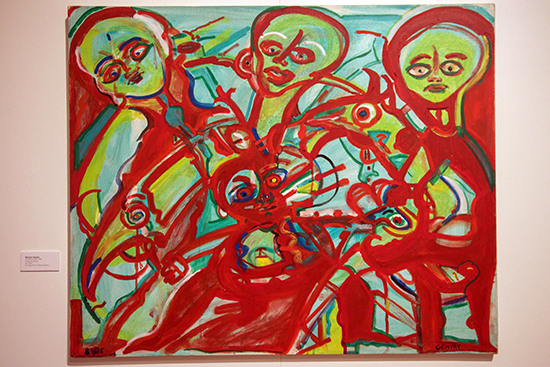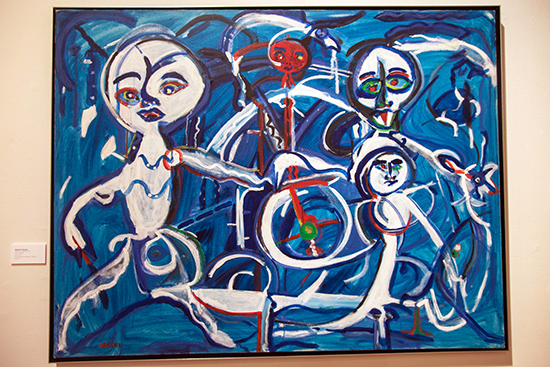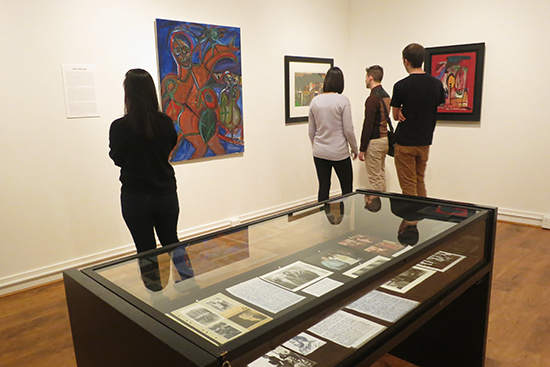Celebrating a Peripatetic Painter at the BU Art Gallery
Herbert Gentry resisted trends, made his art his own

Herbert Gentry was known for his semifigural abstract paintings, like Our Dance, acrylic on canvas (1984-85). Courtesy of G. R. N’Namdi Gallery
Mention the name Herbert Gentry and chances are you’ll draw a blank. The African American abstract painter (1919–2003) never achieved the same degree of fame that friends and contemporaries like Romare Bearden (SED’34) and Kosta Alex did, in part because he spent his career on the move, shuttling between Paris, New York, Copenhagen, and Malmo, Sweden, and often working in several countries at once.
But a new show at the Boston University Art Gallery at the Stone Gallery, titled Making Connections: The Art and Life of Herbert Gentry, should do much to place him among his better-known peers.
“This exhibition sheds light on an artist whose artwork facilitated and inspired an international community of artists and musicians,” says Kate McNamara, BUAG director and chief curator. “His lively paintings reflect an urgency of spirit and offer a narrative of the art world in the mid-century.”
Known chiefly for his semifigural abstract style and for paintings of faces, heads, and masks, both animal and human—all alive with color—Gentry’s signature style had a “circular, web-like look,” says exhibition curator Rachel Tolano (GRS’11,’16), the Jan and Warren Adelson Curatorial Fellow in American Art.
Because he spent so much time traveling from one country to another, Gentry never stayed in one place long enough to establish a reputation, Tolano says. “He was always on the go, and it’s hard to become a pillar in any one community if you’re always jetting off to a different city or continent.” But she offers another explanation of why Gentry is not as well known as some of his contemporaries. “He resisted trends,” she says. “He didn’t go the route of abstract expressionism, even though he was in Greenwich Village in New York between 1951 and 1953. He didn’t go the route of narrative identity-based art when he was back in New York in the early 1970s during the Black Art Movement either.”

Instead, Gentry hewed to his semifigural abstract style, populated with striking images of entangled figures. For example, in Dance Turquoise, four distinct biomorphic figures seem to be tethered together, their features masked by expressive brushstrokes. Similarly, several abstract figures are joined together in Our Dance. Both display Gentry’s mastery of color—shades of turquoise and white, punctuated with red and green in the former, vibrant reds, blues, and greens in the latter. They are characterized by the artist’s signature curvilinear brushwork, which gives them a sense of fluid movement.
Gentry’s life was as fascinating as his art. He grew up in Harlem during the Harlem Renaissance. His mother was a dancer and an actress, and as a boy, he followed in her footsteps, touring with Ethel Barrymore in the play Scarlet Sister Mary. He studied art under the Federal Art Project of the Works Progress Administration before serving in the US Army during World War II. His stint in the service brought him at one point to Paris, and he returned there to study art on the G.I. Bill.
Like many mid-century African American artists, Gentry chose to work abroad through much of the 1940s, ’50s, and ’60s, in part to avoid the racism then prevalent in the United States. While living in Paris, he opened the jazz club Chez Honey, named for his first wife. The club became something of a mecca for US expats and visitors—he described it as “the place in Paris for Americans.” It also served as a gallery space for the work of American artists.

While none of Gentry’s work is overtly biographical, it was enormously influenced by the idiom of jazz. “Gentry always insisted his work was uncalculated—that what went onto the canvas was a product of his subconscious,” Tolano says. “His dynamic, seemingly unpredictable compositions mimic the improvised jazz melodies he listened to so often.” One of the current show’s canvases, Couple and Lamp, painted in 1955, could have been inspired by any of the numerous jazz clubs Gentry frequented in Europe. The abstract, nearly featureless figures of a man and a woman are cloaked in candlelight—the club’s shadows and smoking ambience dancing across the canvas.
Gentry spent much of his career working in Scandinavia—first in Copenhagen, then from 1963 until the end of his life in Sweden (although he never gave up his Paris studio). He was drawn to Scandinavia’s egalitarian lifestyle and the avant-garde artists working there. “Culturally, Gentry identified closely with the social democratic ways of these cultures and their emphasis on communal endeavors, versus American individualism, and linking society and art,” notes Tolano. From 1982 until his death in 2003, he lived with his second wife, the painter Mary Anne Rose, at New York’s Chelsea Hotel. And everywhere he went, he made friends, hence the BUAG exhibition title—Gentry was constantly forging new connections.
Tolano has organized the exhibition into three sections—“Paris,” “Scandinavia,” and “New York”—and as well as showing some of the work Gentry created in each place, it includes works by the artists he befriended in each. So the “Paris” section includes Alex’s sculpture The Girl from Panama and Harold Cousins’ welded bronze Le Musicien. There are also wonderful abstracts by Larry Potter and Beauford Delaney on view. Similarly, paintings by Bearden and Norman Lewis appear alongside canvases painted by Gentry during his New York years. The sections place Gentry’s work in context and emphasize his tacit refusal to be swayed by the stylistic camps his friends were pursuing.
“It didn’t feel right to talk about Gentry’s art without talking about Gentry’s people,” says Tolano. “He was a people person and insisted that images from his subconscious were products of his experience and the people he encountered in his life…connections seem to define his life: connecting flights and trains, social connections made with people he met in cafés, and the professional connections he made by networking.”

In putting the show together, Tolano worked closely with Gentry’s widow, Mary Anne Rose. She traveled many times to Rose’s home in the Chelsea Hotel and to her studio in Queens. Tolano spent “long hours,” with Rose, she says, talking “about Gentry, their lives together, going through his personal archives, and a lot of emailing.”
Tolano was unaware of Gentry until she took over as exhibition curator after original curator Mamie Hyatt (GRS’12), also a Jan and Warren Adelson Curatorial Fellow in American Art, died unexpectedly in Sweden, where she was researching Gentry on a Fulbright fellowship. Hyatt’s advisor, Patricia Hills, a College of Arts & Sciences professor of history of art and architecture, knew Tolano was well-versed in African American art and had the necessary background knowledge and asked her to take over the project.
In putting the show together, Tolano says, she had two goals: first, to demonstrate the diversity of African American art, and second, “to bring to light a whole multicultural community of peripatetic avant-garde artists who, like Gentry, didn’t really call one country home.”
On both counts, she’s succeeded.
Making Connections: The Art and Life of Herbert Gentry is at the Boston University Art Gallery at the Stone Gallery, 855 Commonwealth Ave., through March 30. The gallery is open Tuesday through Friday from 10 a.m. to 5 p.m. and Saturday and Sunday from 1 to 5 p.m. It is free and open to the public. The gallery will be closed March 8 to 16.
Comments & Discussion
Boston University moderates comments to facilitate an informed, substantive, civil conversation. Abusive, profane, self-promotional, misleading, incoherent or off-topic comments will be rejected. Moderators are staffed during regular business hours (EST) and can only accept comments written in English. Statistics or facts must include a citation or a link to the citation.